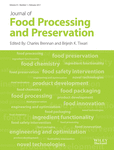Mathematical Modeling of Drying Kinetics of Persimmon Fruits (Diospyros kaki cv. Fuyu)
Abstract
The purpose of this study was to study the modeling of the osmo-convetive drying kinetic and determine the effective mass diffusivity coefficient of Persimmon (Diospyros kaki cv. Fuyu) fruits. The fruit was subjected to osmo-convective drying at three different temperatures (50, 55, and 60C) and 10 different thin-layer semiempirical mathematical models were adjusted to experimental data. Then, according to the highest correlation coefficient (R2) and the least χ2 analysis the attained results showed the Midilli's model as the best option to describe the experimental data at the studied temperatures. In addition, the effective mass diffusivity coefficients were 1.04 × 10−6, 1.40 × 10−6, and 8.27 × 10−7 m2/s at 50, 55, and 60C, respectively. These results can be interesting to food data collection, drying equipment design and to support technical research in food process simulation.
Practical Applications
The osmo-convective drying process is widely used for foods dried production or with reduced water content. In fact, the post-harvest losses can be avoided, since that dried persimmon by osmo-convective drying, exhibit a good quality and extended shelf-life. Thus, the application of mathematical models to describe experimental data of this drying process achieves great practical importance because the number of laboratory tests can be reduced and it makes possible to obtain important parameters such as drying time, mass diffusion coefficient, among others, necessary to conception of processes and dryers.




